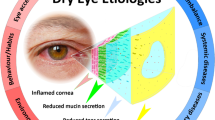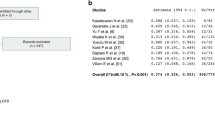Abstract
Background
Dry eye is the most common eye disorder of tears and ocular surface. However, the extent to which diabetes mellitus may confer risk of dry eye remains uncertain. The aim of this study was to perform a meta-analysis that synthesizes the association between diabetes mellitus and dry eye.
Methods
Case–control studies were selected from the Medline, Embase, Cochrane database from January 2000 to March 2018. Two reviewers screened potential studies, and eligible studies were included according to keywords and predefined criteria. We calculated the overall risk estimates by using a fixed-effect model or a random-effects model in relation to heterogeneity.
Results
A total of four studies were included in our meta-analysis consisting of 2,504,794 persons. Our study showed a significant association between diabetes mellitus and the risk of dry eye syndrome (OR 1.30; 95% CI 1.08–1.57; P value = 0.006). However, the heterogeneity was observed (P value < 0.001, I2 = 95.2%).
Conclusion
Our meta-analysis suggests that diabetes mellitus has a significant association with the risk of dry eye. However, this result is limited by heterogeneity. Further prospective and concise studies are needed to confirm the association between diabetes mellitus and dry eye.




Similar content being viewed by others
References
Miljanović B, Dana R, Sullivan DA, Schaumberg DA (2007) Impact of dry eye syndrome on vision-related quality of life. Am J Ophthalmol 143:409–415
Lemp MA, Badouin C, Baum J et al (2007) The definition and classification of dry eye disease: report of the definition and classification subcommittee of the international dry eye workshop. Ocul Surf 5:75–92
Lin MC, Polse KA (2015) Improving care for patients with dry eye symptoms: see what the experts say. Optom Vis Sci Off Publ Am Acad Optom 92:e342–e349
Stapleton F, Alves M, Bunya VY et al (2017) TFOS DEWS II epidemiology report. Ocul Surf 15:334–365
Hom M, De Land P (2006) Self-reported dry eyes and diabetic history. Optom St Louis Mo 77:554–558
Jeganathan VSE, Wang JJ, Wong TY (2008) Ocular associations of diabetes other than diabetic retinopathy. Diabetes Care 31:1905–1912
Manaviat MR, Rashidi M, Afkhami-Ardekani M, Shoja MR (2008) Prevalence of dry eye syndrome and diabetic retinopathy in type 2 diabetic patients. BMC Ophthalmol 8:10
Achtsidis V, Eleftheriadou I, Kozanidou E et al (2014) Dry eye syndrome in subjects with diabetes and association with neuropathy. Diabetes Care 37:210–211
Galor A, Feuer W, Lee DJ et al (2011) Prevalence and risk factors of dry eye syndrome in a United States veterans affairs population. Am J Ophthalmol 152:377–384
Uchino M, Nishiwaki Y, Michikawa T et al (2011) Prevalence and risk factors of dry eye disease in Japan: Koumi study. Ophthalmology 118:2361–2367
Schaumberg DA, Dana R, Buring JE, Sullivan DA (2009) Prevalence of dry eye disease among US men: estimates from the Physicians’ Health Studies. Arch Ophthalmol Chic Ill 127:763–768
Xu K, Yu F-SX (2011) Impaired epithelial wound healing and EGFR signaling pathways in the corneas of diabetic rats. Invest Ophthalmol Vis Sci 52:3301–3308
Ding J, Liu Y, Sullivan DA (2015) Effects of insulin and high glucose on human meibomian gland epithelial cells. Invest Ophthalmol Vis Sci 56:7814–7820
Tang Y-L, Cheng Y-L, Ren Y-P et al (2016) Metabolic syndrome risk factors and dry eye syndrome: a meta-analysis. Int J Ophthalmol 9:1038–1045
Galor A, Feuer W, Lee DJ et al (2012) Depression, post-traumatic stress disorder, and dry eye syndrome: a study utilizing the national United States Veterans affairs administrative database. Am J Ophthalmol 154:340–346
Wang T-J, Wang I-J, Hu C-C, Lin H-C (2012) Comorbidities of dry eye disease: a nationwide population-based study. Acta Ophthalmol (Copenh) 90:663–668
Shah S, Jani H (2015) Prevalence and associated factors of dry eye: our experience in patients above 40 years of age at a Tertiary Care Center. Oman J Ophthalmol 8:151–156
Yang W, Yang Y-N, Cao J et al (2015) Risk factors for dry eye syndrome: a retrospective case–control study. Optom Vis Sci Off Publ Am Acad Optom 92:e199–e205
Moss SE, Klein R, Klein BK (2000) Prevalence of and risk factors for dry eye syndrome. Arch Ophthalmol 118:1264–1268
Chia E-M, Mitchell P, Rochtchina E et al (2003) Prevalence and associations of dry eye syndrome in an older population: the Blue Mountains Eye Study. Clin Experiment Ophthalmol 31:229–232
Viso E, Rodriguez-Ares MT, Gude F (2009) Prevalence of and associated factors for dry eye in a Spanish adult population (the Salnes Eye Study). Ophthalmic Epidemiol 16:15–21
Jie Y, Xu L, Wu YY, Jonas JB (2009) Prevalence of dry eye among adult Chinese in the Beijing Eye Study. Eye Lond Engl 23:688–693
Jeong HS, Lim JS, Oh DK et al (2011) Prevalence and risk factors of dry eye syndrome in the Incheon Area. J Korean Ophthalmol Soc 52:1135–1141
Vehof J, Kozareva D, Hysi PG, Hammond CJ (2014) Prevalence and risk factors of dry eye disease in a British female cohort. Br J Ophthalmol 98:1712–1717
Roh HC, Lee JK, Kim M et al (2016) Systemic comorbidities of dry eye syndrome: the Korean National Health and Nutrition Examination Survey V, 2010–2012. Cornea 35:187–192
Man REK, Veerappan AR, Tan S-P et al (2017) Incidence and risk factors of symptomatic dry eye disease in Asian Malays from the Singapore Malay Eye Study. Ocul Surf 15:742–748
Alshamrani AA, Almousa AS, Almulhim AA et al (2017) Prevalence and risk factors of dry eye symptoms in a Saudi Arabian population. Middle East Afr J Ophthalmol 24:67–73
Gong Y-Y, Zhang F, Zhou J et al (2017) Prevalence of dry eye in uyghur and han ethnic groups in Western China. Ophthalmic Epidemiol 24:181–187
Ferrero A, Alassane S, Binquet C et al (2018) Dry eye disease in the elderly in a French population-based study (the Montrachet study: maculopathy, Optic Nerve, nuTRition, neurovAsCular and HEarT diseases): prevalence and associated factors. Ocul Surf 16:112–119
Zhang X, Zhao L, Deng S et al (2016) dry eye syndrome in patients with diabetes mellitus: prevalence, etiology, and clinical characteristics. J Ophthalmol 2016:8201053
Goebbels M (2000) Tear secretion and tear film function in insulin dependent diabetics. Br J Ophthalmol 84:19–21
Yoon K-C, Im S-K, Seo M-S (2004) Changes of tear film and ocular surface in diabetes mellitus. Korean J Ophthalmol KJO 18:168–174
Yu L, Chen X, Qin G et al (2008) Tear film function in type 2 diabetic patients with retinopathy. Ophtalmol Int J Ophthalmol Z Augenheilkd 222:284–291
Kaiserman I, Kaiserman N, Nakar S, Vinker S (2005) Dry eye in diabetic patients. Am J Ophthalmol 139:498–503
Beckman KA (2014) Characterization of dry eye disease in diabetic patients versus nondiabetic patients. Cornea 33:851–854
DeMill DL, Hussain M, Pop-Busui R, Shtein RM (2016) Ocular surface disease in patients with diabetic peripheral neuropathy. Br J Ophthalmol 100:924–928
Lin X, Xu B, Zheng Y et al (2017) Meibomian gland dysfunction in type 2 diabetic patients. J Ophthalmol 2017:3047867
Nepp J, Abela C, Polzer I et al (2000) Is there a correlation between the severity of diabetic retinopathy and keratoconjunctivitis sicca? Cornea 19:487–491
Malik RA, Kallinikos P, Abbott CA et al (2003) Corneal confocal microscopy: a non-invasive surrogate of nerve fibre damage and repair in diabetic patients. Diabetologia 46:683–688
Ozdemir M, Buyukbese MA, Cetinkaya A, Ozdemir G (2003) Risk factors for ocular surface disorders in patients with diabetes mellitus. Diabetes Res Clin Pract 59:195–199
Baek J, Doh SH, Chung SK (2015) Assessment of the tear meniscus using optical coherence tomography in patients with type 2 diabetes mellitus. Cornea 34:1534–1540
Inoue K, Okugawa K, Amano S et al (2005) Blinking and superficial punctate keratopathy in patients with diabetes mellitus. Eye Lond Engl 19:418–421
Eissa IM, Khalil NM, El-Gendy HA (2016) A controlled study on the correlation between tear film volume and tear film stability in diabetic patients. J Ophthalmol 2016:5465272
Akinci A, Cetinkaya E, Aycan Z (2007) Dry eye syndrome in diabetic children. Eur J Ophthalmol 17:873–878
Fuerst N, Langelier N, Massaro-Giordano M et al (2014) Tear osmolarity and dry eye symptoms in diabetics. Clin Ophthalmol Auckl NZ 8:507–515
Gunay M, Celik G, Yildiz E et al (2016) Ocular surface characteristics in diabetic children. Curr Eye Res 41:1526–1531
Dogru M, Katakami C, Inoue M (2001) Tear function and ocular surface changes in noninsulin-dependent diabetes mellitus. Ophthalmology 108:586–592
Gekka M, Miyata K, Nagai Y et al (2004) Corneal epithelial barrier function in diabetic patients. Cornea 23:35–37
Viso E, Gude F, Rodríguez-Ares MT (2011) The association of meibomian gland dysfunction and other common ocular diseases with dry eye: a population-based study in Spain. Cornea 30:1–6
Shamsheer RP, Arunachalam C (2015) A clinical study of meibomian gland dysfunction in patients with diabetes. Middle East Afr J Ophthalmol 22:462–466
Yagci A, Gurdal C (2014) The role and treatment of inflammation in dry eye disease. Int Ophthalmol 34:1291–1301
Liu J, Shi B, He S et al (2010) Changes to tear cytokines of type 2 diabetic patients with or without retinopathy. Mol Vis 16:2931–2938
Park JH, Kang S-S, Kim JY, Tchah H (2016) Nerve growth factor attenuates apoptosis and inflammation in the diabetic cornea. Invest Ophthalmol Vis Sci 57:6767–6775
Alves M, Calegari VC, Cunha DA et al (2005) Increased expression of advanced glycation end-products and their receptor, and activation of nuclear factor kappa-B in lacrimal glands of diabetic rats. Diabetologia 48:2675–2681
Grus FH, Sabuncuo P, Dick HB et al (2002) Changes in the tear proteins of diabetic patients. BMC Ophthalmol 2:4
Ghosh S, Ghosh S, Azharuddin M et al (2014) Change in tear protein profile in diabetic retinopathy with duration of diabetes. Diabetes Metab Syndr 8:233–235
Li B, Sheng M, Xie L et al (2014) Tear proteomic analysis of patients with type 2 diabetes and dry eye syndrome by two-dimensional nano-liquid chromatography coupled with tandem mass spectrometry. Invest Ophthalmol Vis Sci 55:177–186
Zhang C, Xi L, Zhao S et al (2016) Interleukin-1β and tumour necrosis factor-α levels in conjunctiva of diabetic patients with symptomatic moderate dry eye: case-control study. BMJ Open 6:e010979
Author information
Authors and Affiliations
Corresponding author
Ethics declarations
Conflict of interest
The authors declare that they have no conflict of interest.
Ethical approval
All procedures performed in studies involving human participants were in accordance with the ethical standards of the institutional and national research committee and with the 1964 Helsinki Declaration and its later amendments or comparable ethical standards.
Informed consent
This article does not contain any studies with human participants or animals performed by any of the authors.
Additional information
Publisher's Note
Springer Nature remains neutral with regard to jurisdictional claims in published maps and institutional affiliations.
Rights and permissions
About this article
Cite this article
Yoo, T.K., Oh, E. Diabetes mellitus is associated with dry eye syndrome: a meta-analysis. Int Ophthalmol 39, 2611–2620 (2019). https://doi.org/10.1007/s10792-019-01110-y
Received:
Accepted:
Published:
Issue Date:
DOI: https://doi.org/10.1007/s10792-019-01110-y




